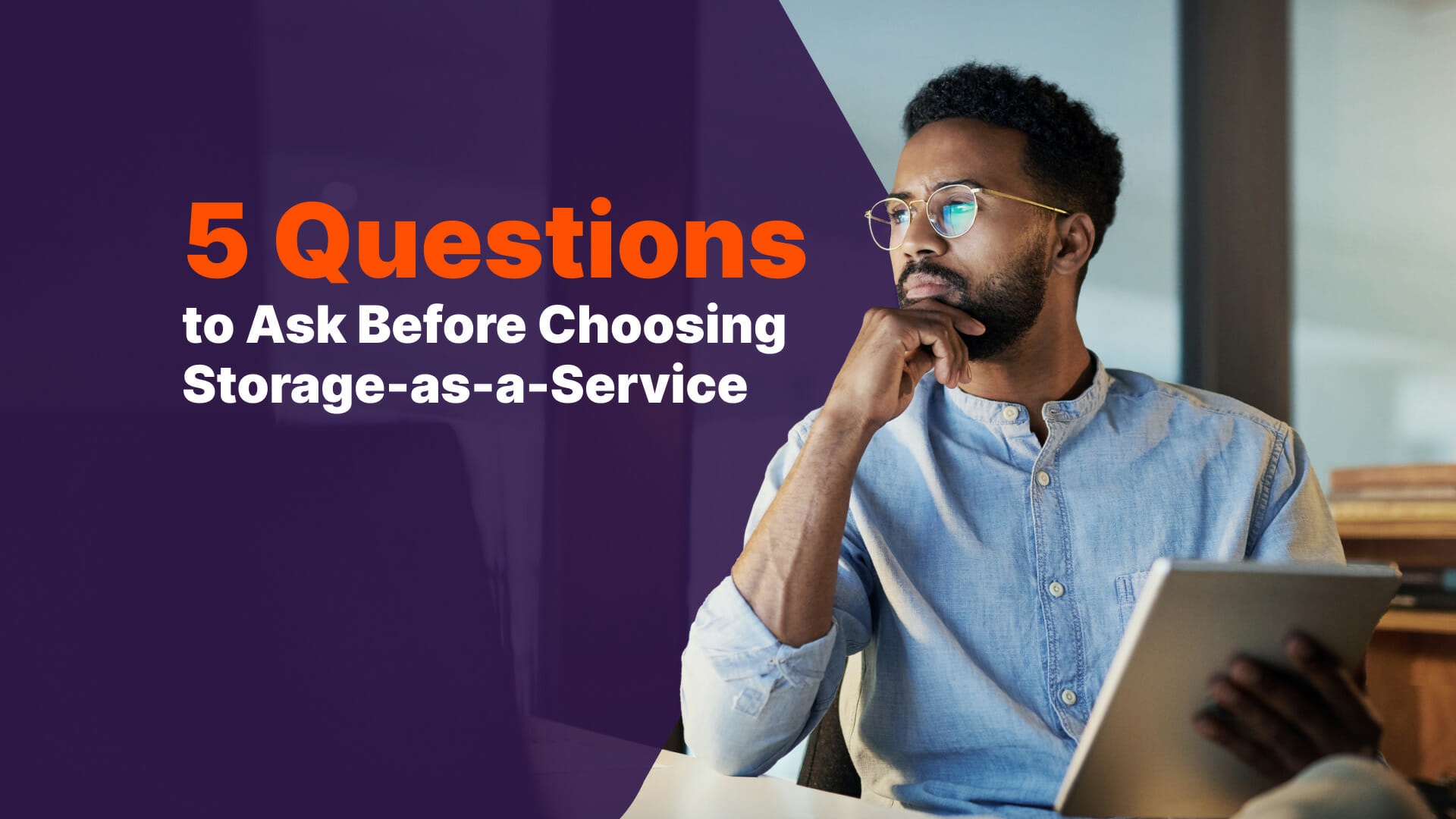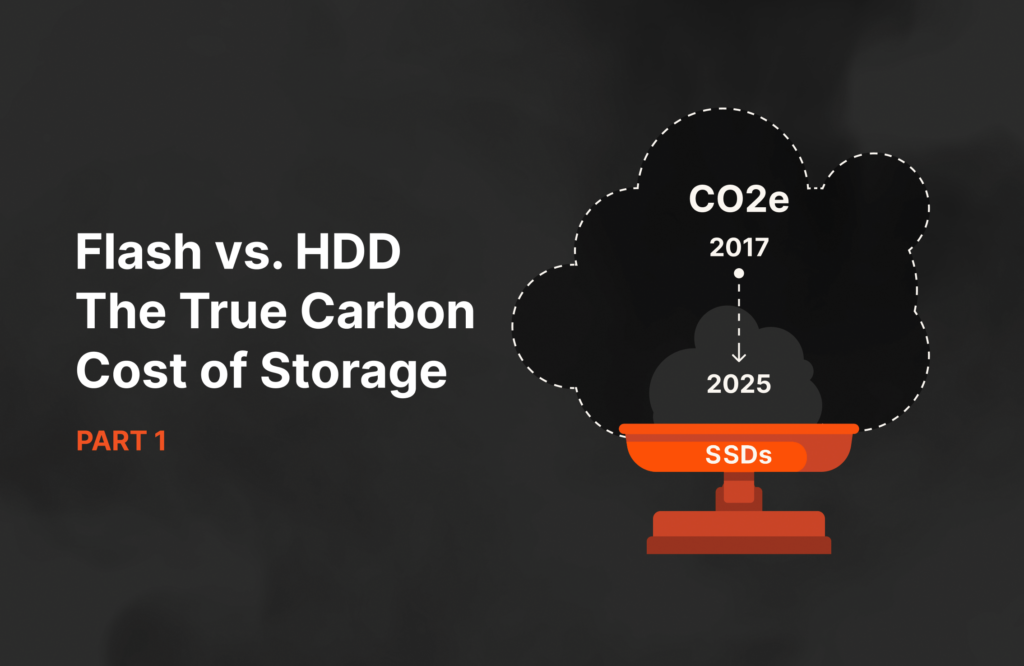Considering storage-as-a-service STaaS)? Not all STaaS offerings are created equal—but here’s how to suss out the solution that’s right for you and what questions to ask before choosing storage as-a-service.
Traditional storage solutions, which largely feature capacity-based, three-to-five-year, rip-and-replace product life cycles are simply no longer able to meet the demands of modern digital businesses. What organizations need is a storage solution that keeps costs manageable while aligning more closely to IT, finance, and business strategies. For many, that solution is storage as a service (STaaS).
Storage as-a-service empowers organizations with the increased agility and resiliency they need and reduces their storage management burden so IT teams can spend more time on innovative projects that build value and increase revenue.
Given the critical importance of data storage, here are five questions to ask before selecting a STaaS provider and solution:
1. Does the storage as-a-service vendor refer to its solution solely in terms of capacity?
If a vendor only talks about capacity percentages when it comes to STaaS, that could be a red flag. Data, not capacity, is the optimal unit of measure in STaaS offerings. In the past, if you had insight into what initiatives were coming up in the near future—and considered that there could be large unexpected events on the horizon—you would naturally increase capacity to accommodate future needs. But forecasting is increasingly unreliable, so it’s smarter today to consider data volumes, not necessarily capacities.
Data volumes are a more important term in STaaS because you only pay for actual storage consumption. Your capacity can scale or shrink as workloads change and needs evolve. Because the storage capacity you use equals the amount of data put on the STaaS platform, you’re able to keep budgets and costs aligned more closely with application performance.
2. What kind of protection does the solution provide in terms of data security, data recovery, etc.?
A good STaaS solution should be straightforward about mitigating risks and vulnerabilities. It should provide a transparent and predictable way to forecast costs and manage budgets. Look for a STaaS solution that offers business continuity, disaster recovery, and cyber resilience capabilities, including ransomware mitigation. Features such as secure data erasure, asset decommissioning, and strong access authentication are important.
Also, ask about industry certifications if applicable, such as HIPAA guidelines for a healthcare company or FINRA for a financial firm. If the vendor can’t speak to the solution’s level of compliance with your industry’s regulations, it might not be the right choice.
The best STaaS solutions are the ones where all the hardware and software were developed, deployed, and operated with security in mind. They also typically include capabilities such as:
- Anomaly detection to detect rare events that could signal a breach
- Vulnerability assessments that are clear and proactive
- Recovery features such as immutable snapshots and alerts
- Clean storage systems and onsite technical assistance in getting back up and running after an attack
3. What kind of SLAs or service guarantees does the vendor offer?
A service level agreement (SLA) is an important contract between you and a solution provider that lays out what you can expect from that provider and solution. It should include details or guarantees that the provider will maintain certain levels of service, such as cost, performance, access speeds, energy efficiency, ransomware, and the volume of data you can store. It should also specify what the provider will do if any of those guarantees aren’t maintained.
Ask your vendor what happens if SLAs aren’t met. Does the provider offer SLAs or service guarantees with service credits and remediation? A good STaaS vendor will manage and update the deployed solution without having to disrupt services.
Tip: Beware if the vendor insists they never experience unexpected downtime. Outages happen, and downtime can be planned.
4. Does the STaaS solution allow you to deploy everywhere you need to—with a single unified bill and no upfront CAPEX investment?
As more enterprises move toward a hybrid or multi-cloud IT ecosystem, it’s important to find a STaaS solution that allows you the freedom and flexibility to deploy storage where you want it. A good solution should deliver a consistent, high-quality storage experience whether your data is stored on-premises, in a colocation facility, a public cloud, private cloud, or hybrid environment. It should also support seamless data migration between all of those locations as well.
Be sure to select a STaaS provider that offers a unified storage subscription for hybrid or multi-cloud environments and doesn’t charge an exit penalty. One bill for all of your stored data greatly simplifies cost management and allows you to predict storage costs without surprises. Even if you’re not currently using a hybrid IT model, a STaaS solution that allows for that is still a smart choice so you can grow and evolve your business and storage needs the way you want, without being penalized or having to make compromises.
5. Does the STaaS solution use advanced technologies such as AI and machine learning (ML)?
Unlike traditional approaches to storage, STaaS isn’t constrained by outdated technology and paradigms. It’s able to incorporate technologies like AI and ML to even further increase storage agility and efficiency. While it might not necessarily be a deal-breaker to choose a solution that doesn’t use AI and ML, you’ll be missing out on a lot of benefits.
The best STaaS solutions use AI and ML to automatically optimize workload placement, which helps avoid hotspots or over- and under-provisioning. With AI and ML, a solution can also offer predictive insights and proactive recommendations about utilization, costs, energy consumption, performance, data security, and more—and help your operations teams improve management of the data your organization generates. The technology enables a high degree of automation of tasks that used to take human teams a lot of time and effort. Automating those tasks also helps reduce the potential for human error.
Skip the Fine Print and Choose STaaS from Pure Storage Evergreen//One
When looking for the best STaaS provider, asking the right questions is critical. STaaS solutions can vary widely in the features and capabilities they offer. You want to choose a solution and proven provider that can support not only your goals and initiatives today but in the future as you continue to innovate, transform, and grow.
There’s a lot to consider, which is why we created Storage as a Service for Dummies to help you know what to look for and how to use STaaS to your advantage. A true STaaS solution has the power to enable you to innovate, improve efficiency, and boost productivity. Our Evergreen//One™ storage as a service (STaaS) delivers all of that and more, with industry-first energy efficiency and ransomware recovery SLAs.
True STaaS changes the storage management game entirely by bringing agility and simplicity to data operations. Leveraging AIOps, true STaaS makes underlying data infrastructure complexity invisible—eliminating the burden of day-to-day storage administration across the service life cycle. And it enables IT teams to focus on business outcomes instead of infrastructure.
Download the Storage as a Service for Dummies ebook for more STaaS insights and learn more about Evergreen//One.





